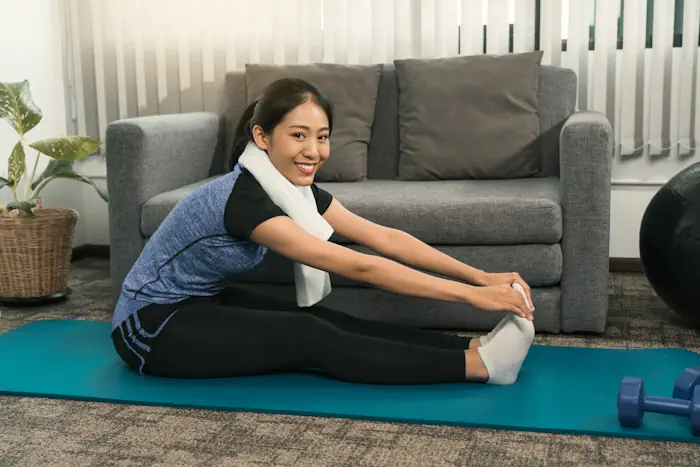Topics
Bringing a new life into the world via caesarean section (C-section) is an amazing adventure filled with excitement and challenges. However, regaining your pre-pregnancy physique can be tough as you navigate the early days of parenting.
When to Start Exercise After a C-Section?
Medical professionals recommend waiting until your postpartum checkup, usually around 6 to 8 weeks after the surgery, before beginning any formal exercise routine. This period allows your incision site to heal, prevents potential complications, and allows you to gradually ease back into physical activity.
How Much Time Does It Take To Get Back in Shape After a C-Section?
It takes at least eight weeks for your incision to heal and your stomach to return to its normal shape. Some women might take longer, and other bellies might permanently take on a different appearance.
Do allow your body time to heal and be patient - remember that it took nine months for your body to grow the baby.
Why Is Postnatal Exercise Important?
Recovering from a C-section involves caring for your baby and tending to your physical well-being.
Post-C-section fitness can be challenging due to muscle and tissue healing, but progress can be made with patience, proper guidance, and consistent effort.
Engaging in postnatal exercises offers an array of benefits that will positively impact overall health, including in the following ways:
- Promotes muscle recovery and strength: Gentle exercises help rebuild abdominal and pelvic muscles weakened during pregnancy and childbirth.
- Enhances mood and reduces postpartum depression risk: Physical activity triggers the release of endorphins, natural mood elevators that can alleviate feelings of stress and depression.
- Aids in weight management: Regular exercise aids in shedding post-pregnancy weight and promoting a healthy body composition.
- Boosts energy levels: Physical activity can enhance your stamina and energy, making it easier to cope with the demands of motherhood.
What Are the Types of Post C-Section Exercises?
Appropriate post-C-section exercises are crucial for a healthy recovery and gradual return to fitness. Do consult your doctor before exercising to ensure they align with your recovery progress:
1. Seated Pelvic Floor Muscles Exercises (PFME)
- Pelvic floor exercises target your pelvic floor muscles.
- Sit comfortably and contract your pelvic floor muscles, holding for a few seconds before releasing. Repeat this multiple times throughout the day to strengthen your pelvic area.
- To locate your pelvic muscles, squeeze in the muscles around the urethra, like you would if you were stopping urine flow. The muscles that contract are the pelvic floor muscles.
2. Breathing exercise or abdominal breathing (diaphragmatic breathing)
- Diaphragmatic breathing is a gentle exercise that assists in strengthening your core muscles while promoting relaxation.
- Breathing exercises have also been demonstrated to improve pulmonary function in females who have undergone C-section.
- To do this exercise, sit up with one hand on your chest and the other on your belly. Breathe deeply, ensuring your belly rises more than your chest as you inhale. Exhale slowly. This exercise helps strengthen your core muscles.
3. Wall sits
- Wall sits are an excellent exercise to target your leg muscles while engaging your core. It helps strengthen your leg muscles and supports overall lower body stability.
- Stand with your back against a wall and slowly lower your body into a seated position as if you are sitting on an invisible chair. Hold this position for a few seconds before standing up.
4. C-section scar massage
- Massaging your C-section scar is essential to promoting healing and reducing sensitivity.
- Using clean hands, employ gentle circular motions while applying slight pressure to the scar area. However, it is crucial to ask your healthcare provider for advice before attempting this exercise to ensure that the technique aligns with your recovery progress.
5. Forward bend
- A simple forward bend stretch can help alleviate tension in your lower back and hamstrings, which tend to tighten during pregnancy.
- Stand with feet shoulder-width apart, slowly bend forward at the hips while keeping your back straight. Allow your upper body to dangle freely.
6. Walking
- Walking is a low-impact cardiovascular exercise that can be initiated shortly after your C-section, with your healthcare provider's approval.
- Start with short, gentle walks around your home or neighbourhood to prevent strain on your healing incision. Gradually increase your walking distance as you feel comfortable.
- Walking 25-30 minutes a few days a week, approximately eight weeks after your C-section, is recommended. However, do consult your gynaecologist to ensure your body has recovered sufficiently before beginning your walking routine.
7. Light stretching
- Gentle stretching can help alleviate muscle tension, improve flexibility, and enhance overall physical comfort.
- Focus on your neck, shoulders, back, and legs. Incorporate stretches into your daily routine to maintain muscle suppleness and prevent stiffness.
How Can I Flatten My Tummy After a C-Section?
After a C-section, the abdominal area may appear more significant due to swelling and changes in muscle tone. Engaging in postnatal exercises and maintaining a healthy lifestyle can help restore your abdominal shape.
Here are exercises that can help flatten your tummy after a C-section:
1. Bridge
Bridge exercises are often used to strengthen the trunk stability muscles. When repeated, it helps to improve your core and the muscles around your abdomen.
- Lie on your back with knees bent and place your feet flat on the floor.
- Then, engage your glutes and core muscles to lift your hips off the ground.
- Hold this stance for a few seconds before returning your hips to their original position.
2. Leg slides
Leg slides are a gentle yet impactful exercise for your core muscles, promoting stability and strength.
- Lie on your back, feet bent, feet flat on the floor.
- Keep one leg to the side and one foot on the ground.
- Return the leg to the starting position slowly and switch sides.
3. Deadbug
This exercise focuses on core stability and engages multiple muscle groups simultaneously.
- Start by lying on your back. Your knees should be bent and feet flat on the floor.
- Lift your legs, creating a tabletop position with your thighs perpendicular to the ground.
- Slowly extend one leg out while maintaining the tabletop position with the other leg.
- Alternate between legs, ensuring your core muscles are actively engaged throughout the movement.
4. Knee touchdowns
Knee touchdowns are controlled movements that target your core muscles and strengthen your abdominal area.
- Lie on your back with your knees bent.
- Have your feet flat on the floor.
- Gradually lower one knee towards the ground while keeping the foot on the floor.
- Return the knee to the starting position and alternate between sides.
What Are the Exercises to Avoid After C-Section?
In the aftermath of a C-section, understanding which exercises to avoid is paramount to ensure a smooth and risk-free recovery process. High-impact exercises, such as running, jumping, or intense aerobics, should be cautiously approached during the initial post-C-section phase.
When Can I Start High-Impact Exercises After a C-Section?
It is essential to consult your healthcare provider before incorporating high-impact activities into your exercise routine. The first few months following a C-section are crucial for healing and recovery, and avoiding high-impact exercises during this time can prevent strain on your healing incision site and muscles.What Else Can I Do to Get Back in Shape After C-Section?
Beyond exercises, adopting a holistic approach to post-C-section fitness can significantly contribute to your overall well-being. Some of these approaches include:
1. Allow your body time to heal
Patience is critical when it comes to post-C-section fitness. Your body has undergone a significant transformation and allowing it sufficient time to heal is paramount. Rushing into intense exercise routines can lead to complications and hinder your recovery progress. As you gradually resume physical activity, pay attention to your body’s signals and adjust your routine accordingly.
2. Consider nutritional balance
Achieving and sustaining post-C-section fitness requires more than just exercise; nutrition is also essential. A diet rich in critical nutrients, vitamins, and minerals promotes your body's healing and energy levels. Consuming enough protein, fibre, and water to aid faster muscle repair.
3. Warm up and warm down to avoid injuries
Before exercising:
- Prioritise warming up your muscles to prepare them for physical activity.
- Incorporate light cardio and dynamic stretches to increase blood flow and flexibility.
After your workout, do cooling-down stretches to prevent muscle tightness and reduce the risk of injury.
4. Exercise with friends
Participating in group workouts or postnatal fitness classes can offer various benefits beyond the physical aspect. Group settings provide a sense of community, support, and motivation.
Engaging in exercises with fellow mothers allows you to share experiences, gain insights, and create an encouraging network during your post-C-section fitness journey.
Make an Appointment at Pantai Hospitals
Embarking on the journey to regain your pre-pregnancy fitness after a C-section requires dedication, patience, and an awareness of your body's needs. By following a gradual exercise plan, respecting healing time, and seeking professional advice, you can effectively work towards achieving your fitness goals.
Get in touch with us to book an appointment with our team of gynaecologists and physiotherapists today, or find out more about our Obstetrics and Gynaecology Services, as well as our Physiotherapy and Rehabilitation Services at your nearest Pantai Hospital.
Pantai Hospitals have been accredited by the Malaysian Society for Quality in Health (MSQH) for its commitment to patient safety and service quality.
This article has been reviewed by the Pantai Integrated Rehab team.













